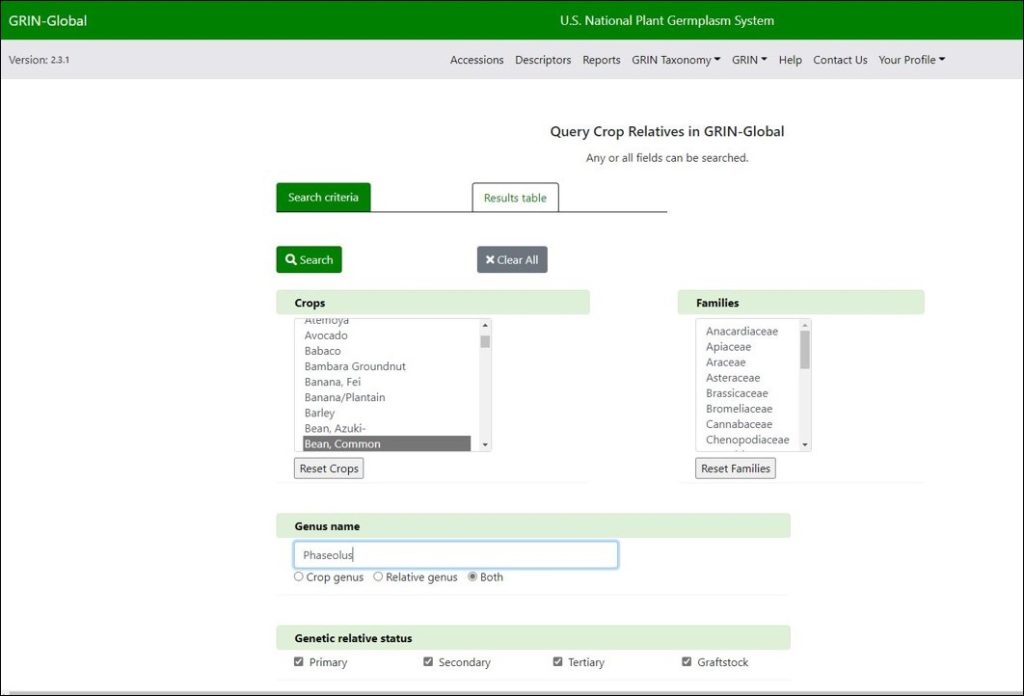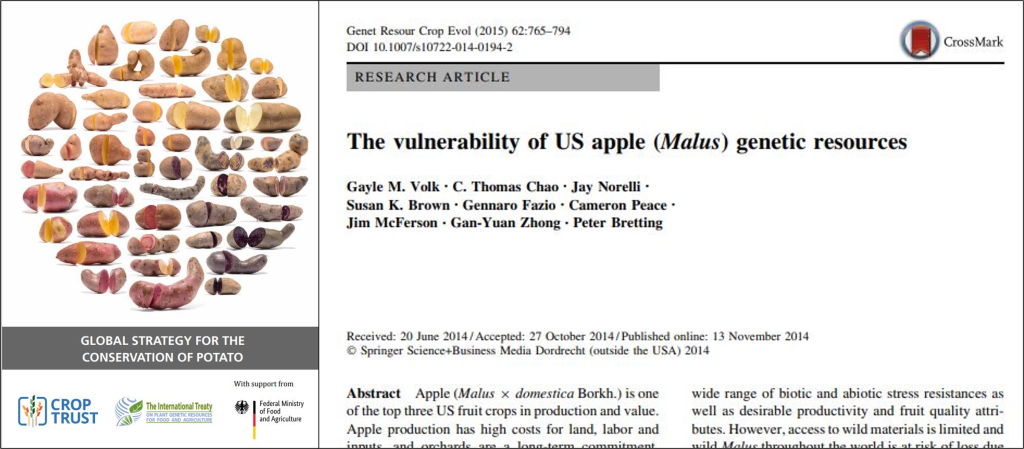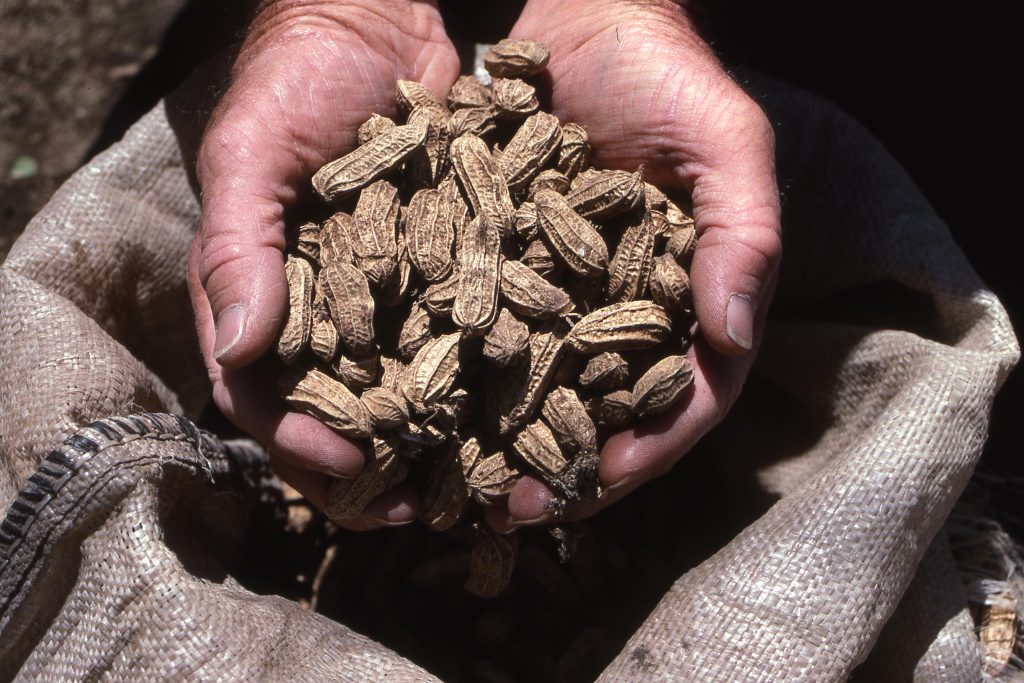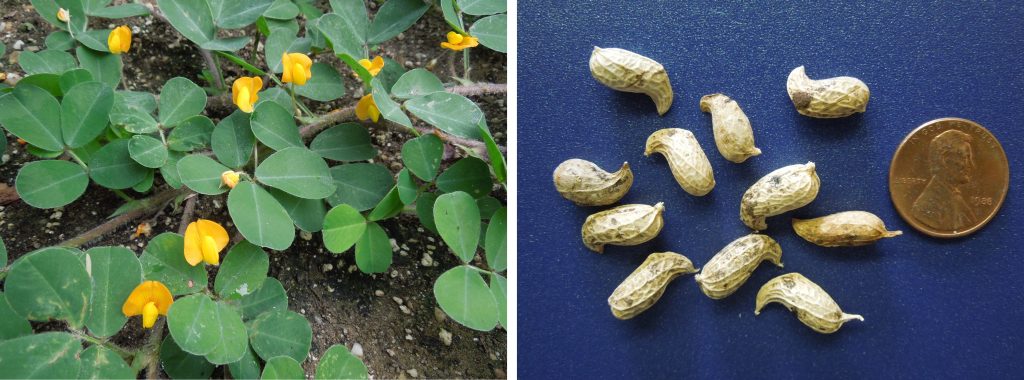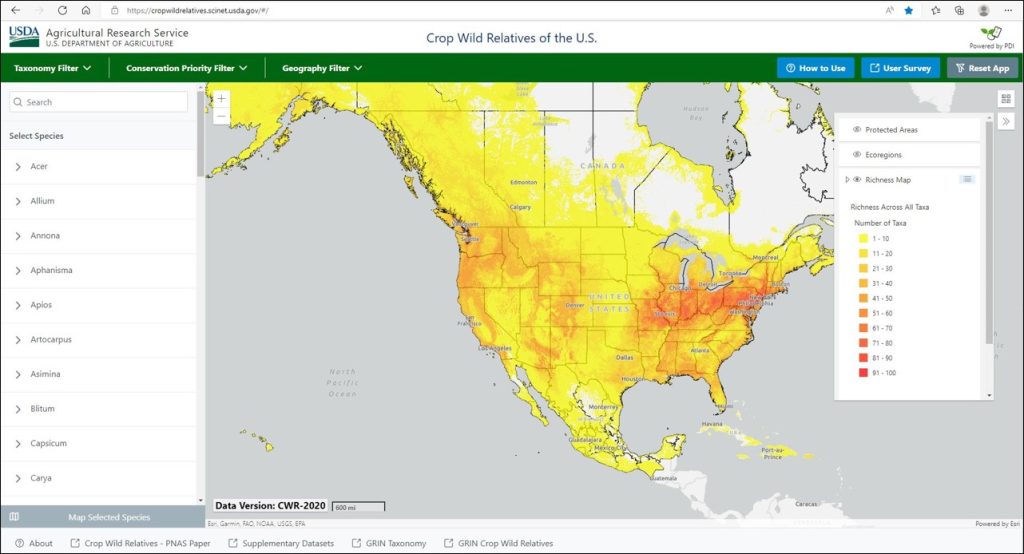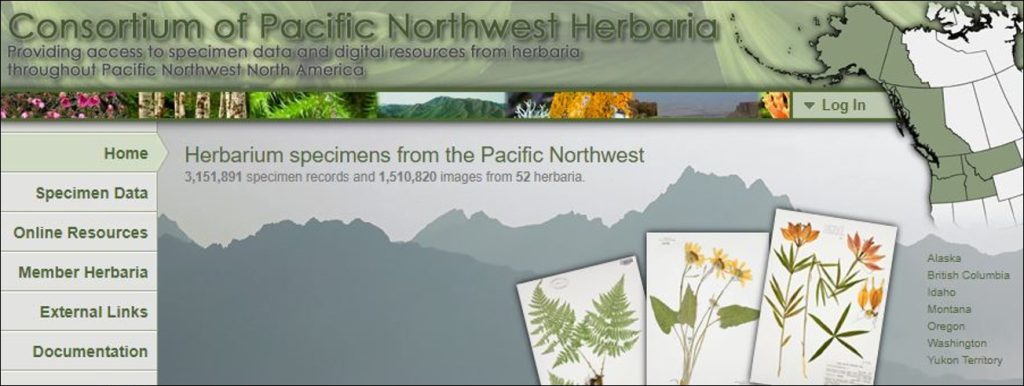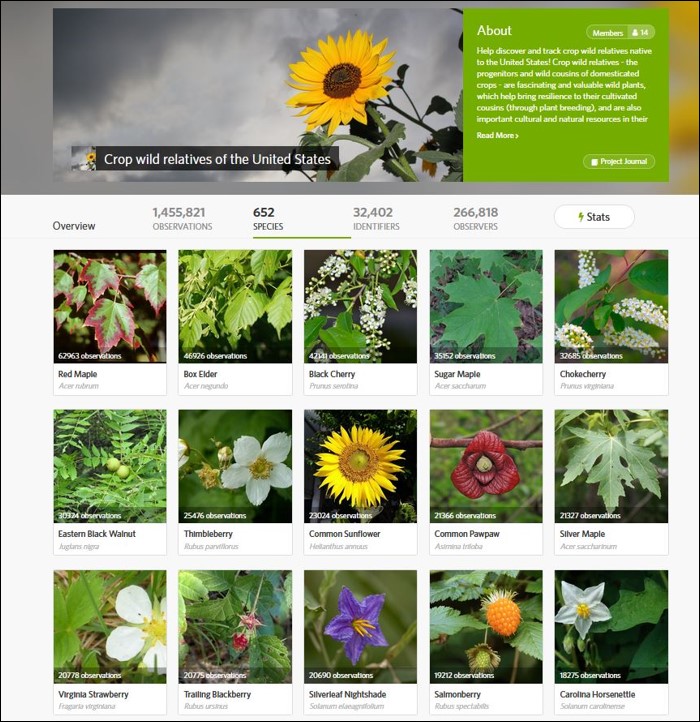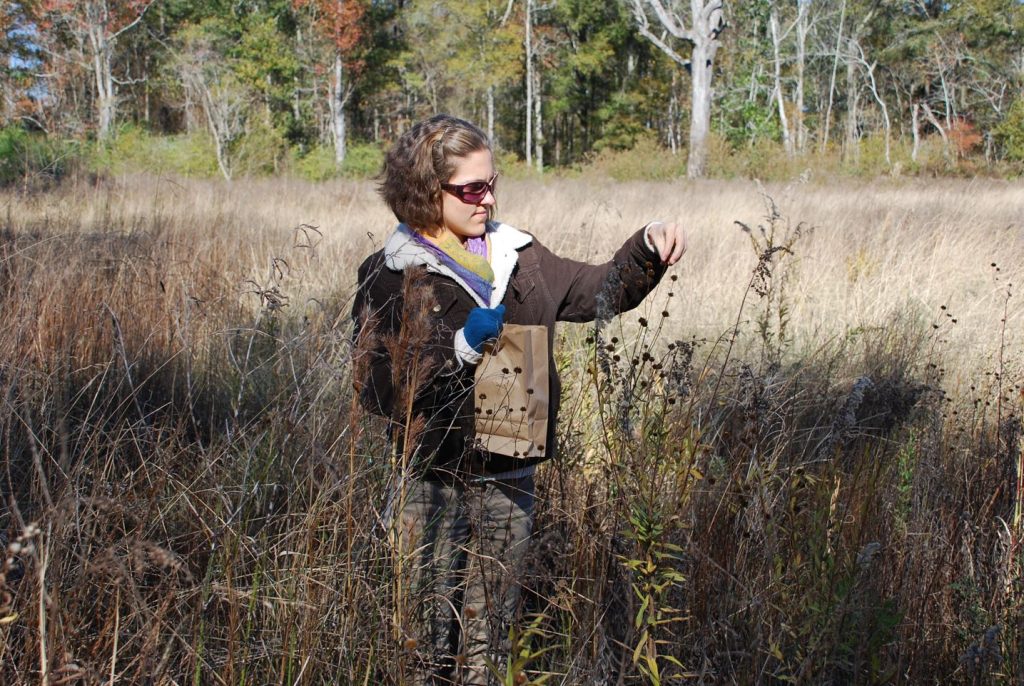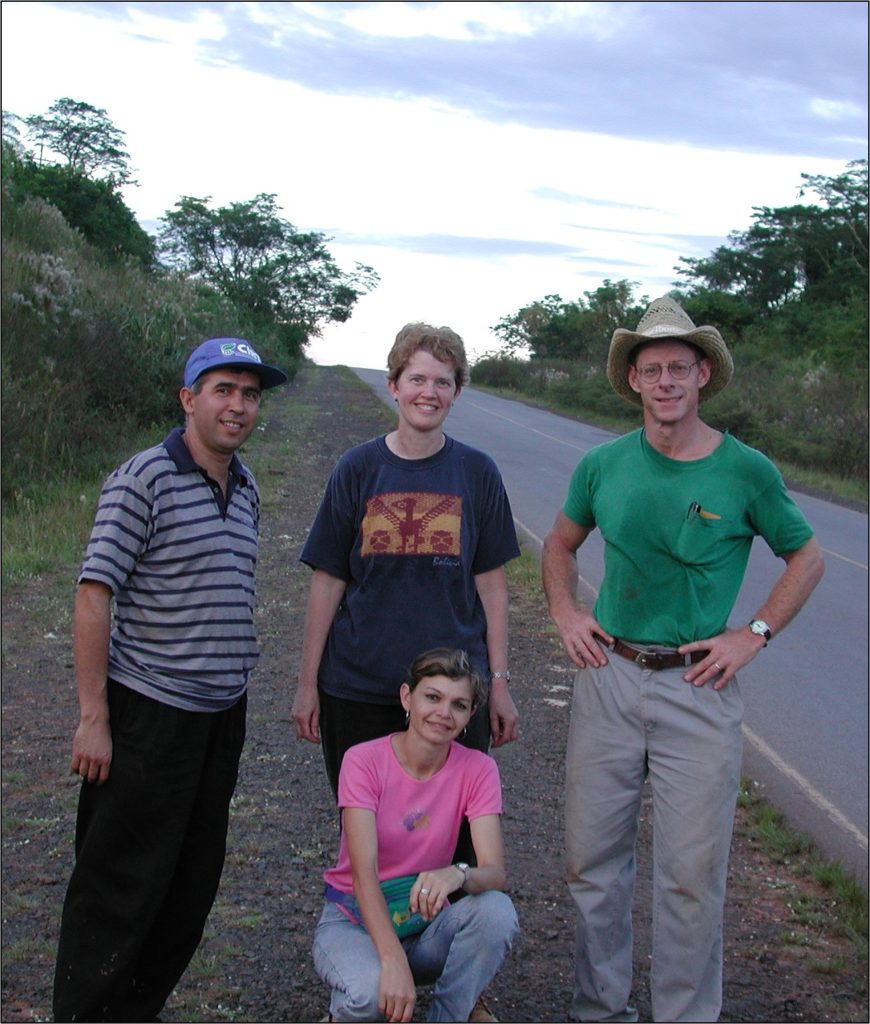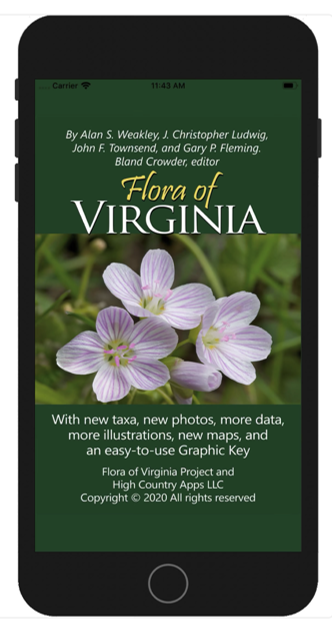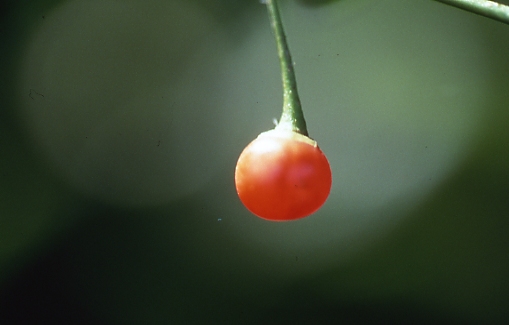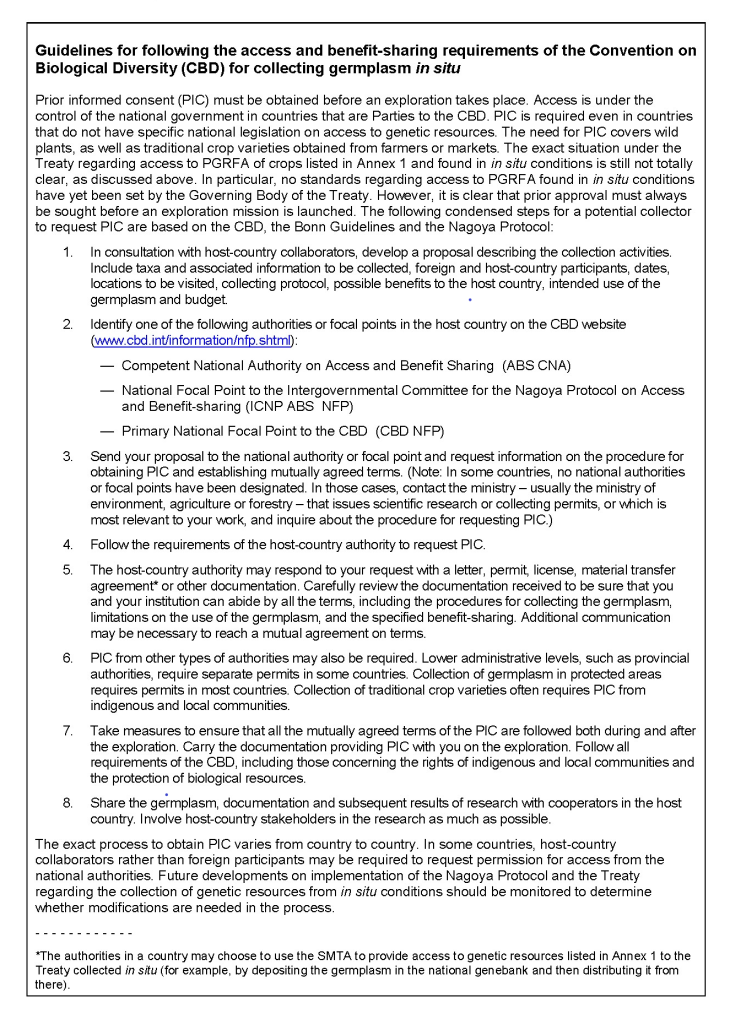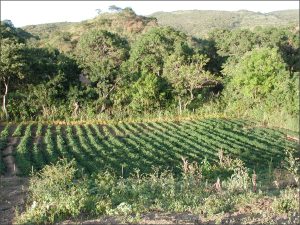Planning an Exploration for Plant Genetic Resources to be Incorporated into the USDA National Plant Germplasm System
Karen A. Williams
Contact: Anne.Frances@usda.gov
Outline
- Background
- Identifying gaps in germplasm collections
- Planning a plant exploration
- Legal and ethical issues
- Conservation issues
- Conclusion
- References
- Additional information
- Acknowledgments
1. Background
Genetic diversity is fundamental to the capacity of wild plants to survive and adapt to variable environmental conditions. It is also the raw material that enables plant breeders to develop crop varieties with resistance to pests and diseases, adaptations to environmental changes, improved nutritional value, and other desired traits. Plant explorations collect samples of this genetic diversity for conservation in genebanks where they are available for a multitude of uses. Plant explorations may be conducted for many purposes, including rescuing plants in danger of genetic erosion or extinction. Plant material may also be needed to restore degraded ecosystems or for other immediate use. Another purpose is the need for material to conduct taxonomic, phylogenetic, or biosystematics research.
This chapter focuses on plant exploration for materials with potential uses in crop improvement, primarily landraces and crop wild relatives (CWR). Landraces are the local varieties selected and propagated by farmers over many generations to meet their needs. They are genetically and morphologically diverse but have distinct characteristics that define them to the farmers who grow them. Crop wild relatives are the direct ancestors of crops or more distant relatives. They may be native to the center of origin of the crop or other locations, including distant lands. The first step in planning a plant exploration for landraces or CWR is determining which taxa and locations are the priorities. Plant explorations are only necessary when the targeted material is not already present and accessible in germplasm collections.
The USDA Plant Exploration Program
The Plant Exchange Office of the United States Department of Agriculture – Agricultural Research Service (USDA-ARS) National Germplasm Resources Laboratory and its predecessors have been supporting plant explorations for well over a hundred years (Williams, 2005; see associated eBook chapter). For many decades after the founding of the Office of Foreign Seed and Plant Introduction in 1898, full-time USDA plant explorers traveled the world collecting germplasm. Before the establishment of the genebanks that eventually became the components of the National Plant Germplasm System (NPGS), much of the collected germplasm was sent to USDA Plant Introduction Gardens and other locations for evaluation and was not preserved long term. Since the establishment of permanent USDA plant genebanks, samples collected on USDA plant explorations are sent to the appropriate genebank. Modern plant explorations supported by the Plant Exchange Office are selected from proposals prepared according to standard guidelines and submitted yearly. Any qualified scientist in the U.S. can submit a proposal with the understanding that all collected germplasm is deposited in the NPGS.
2. Identifying gaps in germplasm collections
The gaps in germplasm collections usually fall under the general categories of taxonomic, genetic, geographic, or ecological. Analyses of gaps in collections of landraces, which are the product of human interaction, must also consider farmers’ role in their development, diffusion, and maintenance. Identification of gaps in collections requires a broad knowledge of the target genepool, including:
- Taxonomy
- Evolutionary relationships between a crop and its wild relatives
- Crop center of origin; history of domestication and spread
- Geographic and ecogeographic distribution of genetic diversity
- Distribution of genetic diversity within and between populations
- Genetic relatedness and reproductive characteristics of taxa
Useful resources for information on these characteristics include scientific literature, experts on the targeted taxa, previous germplasm collections, and herbarium specimens from international and local herbaria. For information on taxonomy, consult GRIN Taxonomy, which includes extensive information on crop wild relatives and their relationship to crops. Maps or map layers of many types, including climatic, soil, topographic, vegetation, land use, and socioeconomic data provide valuable information related to environments not represented in collections. Geographical information systems (GIS) can be helpful for organizing and analyzing the many types of data and identifying geographic areas that are likely to contain specific traits, taxa, or habitats. They can also highlight areas that are ecologically highly diverse, underrepresented in collections or threatened with genetic erosion (Guarino et al., 2002).
Figure 1. The Crop Wild Relative webpage of GRIN Taxonomy
The Crop Vulnerability Statements developed by the Crop Germplasm Committees that are associated with the U.S. National Plant Germplasm System (NPGS) address gaps in the germplasm collections in genebanks, especially within the NPGS. The Global Crop Strategies coordinated by the Crop Trust evaluate gaps in worldwide collections for some crops. Information on germplasm in the NPGS is available from GRIN-Global. Information on germplasm in genebanks worldwide, including the CGIAR International Agricultural Research Centers, can be obtained through the GENESYS portal. The Botanic Gardens Conservation International’s PlantSearch database enables sending requests to multiple institutions simultaneously for information on ex situ collections for selected taxa.
Figure 2. Global Conservation Strategy for Potato (left; Nagel et al., 2022) and Crop Vulnerability Statement developed by the NPGS Apple CGC (right; Volk et al., 2015).
2.1 Landraces
Most crop species are represented in genebanks to some degree, but gaps often exist in the coverage of landraces. An urgency to fill these gaps exists because locally developed varieties for many crops are disappearing due to numerous factors, including adoption of genetically uniform varieties, replacement with other crop species, market changes, seed system deficiencies, climate change, and land-use changes (Khoury et al., 2022).
Figure 3. Peanut landrace from Ecuador (Credit: K.A. Williams).
Information on landraces can sometimes be obtained from specimens in herbarium collections, but these specimens are not as common as those of wild species. Information on the distribution of landraces can be found in historical literature and monographs, and through communications with experts in other countries. A detailed search of the representation of landraces in germplasm collections (national, international, and private) and comparison with their known occurrences is needed to determine where the gaps are.
2.2 Crop wild relatives
The diversity of CWR in ex situ germplasm collections, including the NPGS, is generally low (Castañeda-Álvarez et al., 2016), and the urgency to collect them is increased by threats to natural populations from accelerated changes in land use, over-exploitation of resources, and human-made and natural disasters (Ebert and Engels, 2020; Frances et al., 2018). Furthermore, developments in genomics and advanced data analysis that enable the identification of adaptive alleles and advances in genome editing technologies have improved the prospects for utilization of CWR in plant breeding, making them an even higher priority for collection (Hübner and Kantar, 2021).
Figure 4. Plant and seed of Arachis monticola, a wild relative of the peanut (Credit: K.A. Williams).
Some of the most significant gaps in the NPGS collections are CWR native to the United States (Khoury et al., 2020). These species are untapped resources with tremendous potential to contribute to the productivity, sustainability, and quality traits of agronomic and horticultural crops. Over 600 plant species native to the United States are wild relatives of 37 different crops (Warschefsky and Rieseberg, 2021). In a comprehensive assessment of U.S. CWR, 253 species of the 600 CWR assessed were identified as the species most closely related to crops and, therefore, have the greatest potential for use in breeding programs (Khoury et al., 2020). Over half of the native CWR were determined to be of urgent priority for both in situ and ex situ conservation actions (Khoury et al., 2020). Crop Wild Relatives of the U.S. is an interactive web application developed in collaboration between the study’s authors and the USDA-ARS Partnerships for Data Innovations; this application is searchable and presents the results in a visual format.
Figure 5. Crop Wild Relatives of the U.S. web application.
3. planning a plant exploration
When gaps have been identified and prioritized, the process of planning a plant exploration with the appropriate taxa, approach, locations, and timing can begin. Careful planning is key to a successful exploration.
3.1 location
Thorough background research is necessary for the selection of both general and specific locations for collection of germplasm. The records of germplasm accessions discussed in the section on gap analysis are useful in selecting collection sites, both to identify unrepresented regions and to recollect from populations for which previously collected samples are no longer available. Herbarium voucher records, many of which are available online (e.g., SEINET (Southwestern Environmental Information Network), USF, SERNEC and CPNWH (Consortium of Pacific Northwest Herbaria), are very useful to identify potential collecting sites for wild taxa in the U.S.
Figure 6. Consortium of Pacific Northwest Herbaria website.
For herbaria that do not have all relevant records online, a personal visit to examine specimens is ideal. Contacting herbaria known to house specimens of interest can help guide the decision on whether to visit. Often contacts at such herbaria are willing to send information if visiting is not possible. The Index Herbariorum, a database of herbaria worldwide, is maintained by the Steere Herbarium at the New York Botanical Garden and available online; it facilitates identification of local herbaria that may house specimens of interest. Populations represented by older voucher specimens are less likely to persist today and locations might be more difficult to find for those collected before the introduction of GPS (Marek, 2018). However, these records are good indicators of the range of the species of interest. The Global Biodiversity Information Facility (GBIF) provides location data on biodiversity of all kinds, including plants, drawn from many types of institutions around the world. Georeferenced photos of wild plants available in citizen science projects, such as iNaturalist, have recent information on locations, as well as observable dates of flowering and fruit production.
Figure 7. The citizen science application iNaturalist has a project focused on crop wild relatives.
3.2 timing and duration
The dates chosen for an exploration are as important as the location. Seed and vegetative storage organs might be available for collection only for short periods of time. Cuttings of some plants can be taken and propagated successfully at any time of year, but stem cuttings of many woody plants can only be taken in the fall or dormant season. Other types of vegetative samples have additional considerations for availability, as well as longevity during transit.
Dates of collection of accessions are sometimes available in genebank databases for both wild species and landraces. For wild species, information on appropriate dates might also be ascertained from floras and monographs. Studying fruiting phenology using herbarium specimens is often the most informative approach. For explorations to collect landraces, especially when the goal is to collect freshly harvested seed from farmers, it is critical to obtain information for harvest dates from local contacts with knowledge of the crop. Collection from farmers’ storage and markets enables a broader time range for an exploration.
Prediction of the best time to collect is based on averages of past conditions, but weather conditions are variable and becoming more so with climate change. It might be necessary to postpone if events such as droughts, late or early freezes, floods, fires, and hurricanes affect the target populations and the transportation network (Marek, 2018).
Figure 8. Collecting Helianthus simulans in Louisiana (Credit: K.A. Williams).
The duration of a plant exploration depends on the number of collection sites, distance between sites, time to travel between sites, and the length of time needed at each site for thorough collecting and documentation. Also, extra time is often needed at the beginning and end of the trip, especially for international explorations. At the beginning of an exploration in another country, it is necessary to meet all hosts and essential government officials, in addition to collaborators. Presentations on the visitor’s research and home institution are usually very welcome. In addition, one or two days might be needed to make final trip preparations (buying supplies; arranging transportation; and finalizing itinerary, responsibilities for expenses, collecting methodology, and plans for division of germplasm). After field work is completed, time is needed to complete documentation, check labeling and cross references to documentation for all samples, clean, prepare, package, and divide germplasm, complete drying of herbarium specimens, and obtain phytosanitary certificates. Phytosanitary certificates might be required to import the collected plant materials into the United States or other countries. Additional information about plant import is available in the Fundamentals of Plant Genebanking eBook chapter titled “Phytosanitary and Regulatory Issues in the Movement of Plant Genetic Resources: A U.S. Perspective“.
3.3 participants
A compact team of between two and four persons is very practical for field collections. More might be needed for certain trips, such as those when participants will split up to visit different sites. The involvement of scientists in the host country who are familiar with the local culture and the targeted plants is critical to the success of plant explorations. It is appropriate for international explorations to be conducted in collaboration with the national genetic resources program if crop genetic resources are the target. For some international explorations, translators who know both the national and local languages might be recommended. Local guides are helpful for some explorations, depending on the familiarity of other participants with the area. Dedicated drivers might also be appropriate for some field conditions.
Figure 9. A compact collecting team for an exploration in Paraguay (Credit: K.A. Williams).
3.4 field plan
In some cases, field reconnaissance might be useful to locate populations or to assess the likelihood and timing of seed availability for collection. For international expeditions, reconnaissance might be possible for local collaborators. Other local contacts with familiarity of the target species can sometimes provide the same information that a reconnaissance mission would provide.
The field party might travel together or divide into groups. Most itineraries are covered primarily by motor vehicle paired with hiking. Travel by boat is necessary to reach some locations inaccessible by roads.
Germplasm could be collected as seed or vegetative material, including cuttings and storage organs. Seeds are the easiest propagule to collect and transport if certain criteria are met. Before the exploration, it should be established if the target plants have seeds and if the seeds can be stored and propagated under ex situ conditions. The perishability of vegetative propagules and recalcitrant seed requires a detailed plan to retain their viability and transmit them promptly to the genebank where they will be maintained.
Figure 10. Collecting fruits of Malus doumeri in Vietnam (Credit: G. Volk).
Seeds might be extracted from some fruits immediately after collecting. Dry fruits might need drying to open the capsule, cone, or pod. The entire fruit in other species (e.g., maple) is treated as a seed. It can take several days to extract seeds from fleshy fruits. If it is necessary to begin extraction of seeds from fleshy fruits during the trip, these could be kept in plastic bags with water during transit as the decomposition of the flesh progresses sufficiently for extraction. Some seeds, such as nuts that are recalcitrant to standard genebank storage conditions, should not be dried.
3.5 equipment
In addition to standard gear for an expedition (first aid kit, camping gear, rain gear, etc.), equipment for collecting and documenting germplasm must be carefully selected. Many explorations focus on collection of seeds, for which envelopes or bags, labels, and markers are necessary. For vegetative specimens, hand or pole pruners are necessary. Calipers and battery-operated balances are useful to measure and describe plant characteristics. Plant presses and pruners are needed for herbarium specimen preparation. Newspapers or other paper for herbarium specimens can usually be obtained locally. Portable herbarium driers are especially useful in areas with high humidity.
Floras, local plant guidebooks, photocopies of herbarium specimens, or other identification guides are essential for collection of wild species when the exploration goals include a variety of different species, some of which might not be well known to the collectors. Floras and field guides are increasingly being made available as apps.
Figure 11. The Virginia flora is one of several floras available as an app.
A global positioning system (GPS) will provide the most precise latitude and longitude. A GPS with a barometric altimeter can replace the need for a standalone altimeter for measurement of elevation.
Digital maps available for use on GPS devices, cell phones, and other electronic devices can assist with navigation in the field. Many applications for mobile devices that can assist with navigation are available. Google Earth can be helpful in planning and can be accessed offline in the field to access small amounts of data that have previously been cached. Topographic maps for the United States can be downloaded from the U.S Geological Service. Paper maps are sometimes used in combination with digital maps, which are often not sufficient for remote locations and serve as a backup when satellites are not available.
Use of GIS to guide plant explorations
Geographical information systems (GIS) can be used in the field as guides on where to collect, based on the specific interests of explorers (Jarvis et al., 2005a,b). In Paraguay, GIS were used to guide a USDA-ARS\Ministerio de Agricultura y Ganaderia exploration for a rare wild pepper species, Capsicum flexuosum, for which previous explorations had been unable to locate germplasm. Exact locations for collecting were identified through a combination of three factors: climatic zones predicted to be suitable for the species, forested areas indicated by land cover maps, and road maps to limit search areas to accessible regions. Fieldwork using the GIS resulted in the location of five previously undocumented populations of the species, one of which was outside its known range.
Figure 12. Wild Capsicum flexuosum located with the assistance of GIS (Credit: K.A. Williams).
3.6 sampling strategy
Most plant species are rich in genetic variation, of which plant explorers can collect only a small fraction. To maximize the collection of genetic variation for conservation, the sampling strategy must be carefully chosen based on the specific objectives and biology of the target taxa. Species vary in breeding systems (outcrossing vs. selfing), plant reproductive morphology (monoecious vs. dioecious, number of seeds per plant), dispersal mechanisms (wind, animal, etc.), and life cycle (annual, biennial, or perennial). Population size, structure, fecundity, and seed-set for the specific collection event influence whether sampling at specific sites will meet the goals of the collection. Landrace and wild populations require different strategies. Different types of propagules, such as seed or vegetative, require different sampling and handling techniques in the field. A basic sampling strategy (Brown and Marshall, 1995) includes:
- the target number and criteria for selection of sampling sites
- the ideal number of individual plants to sample from each population
- how the individual plants within populations are chosen for sampling (random vs. biased sampling methods)
- the number and type of germplasm propagules to collect from each plant
- whether to bulk samples in a population or separate by maternal lines or other criteria
For landrace populations, the sampling unit will be an individual field if different seed stocks of a crop are used on a farm or a group of fields if the same seed stock is used throughout. The seed stocks themselves are often the sampling unit when the crop is not in the field. Random sampling is usually appropriate. The lower amount of genetic variation enables a representative sample to be taken with fewer seeds than for a wild population. For some crops, the sampling unit might be a limited number of plants in a home garden rather than a field. Landraces are also often available from markets or local stores.
Explorations to collect a broad range of genetic diversity in wild species attempt to maximize the number of collecting sites in diverse environments within the constraints of time and funding. Collecting sites are chosen based on ecological zones, distance, and practical factors such as accessibility. To sample the range of genetic diversity in a population, collections throughout the space, including both the edges, and including diverse plant and seed morphologies should be made. For many decades the most widely accepted strategy for seed collection of wild species was based on the recommendation by Marshall and Brown (1975) to collect between 50 and 100 individuals in each population to capture the locally common alleles (those that occur at greater than 0.05 frequency in a population). More recently, it has been recognized that these guidelines are not adequate for many taxa, populations, and environments and do not consider the distribution of genetic diversity within and among populations (Lockwood et al., 2007; Guerrant et al., 2014; Hoban et al., 2018). Knowledge of the taxon’s traits and genetic structure can lead to more complete collection of genetic variation. A genetic survey of the taxon can provide detailed information on the distribution of alleles and genetic structure that will enable the development of the ideal sampling strategy, but cost and time usually make this impossible. In any case, if possible, it is always advisable to collect more than the recommended number of seeds to account for low germination, addition to backup collections, and to have sufficient quantities for regeneration and other uses. Collection in populations of clonally propagated groupings requires a modified strategy and not as many propagules can be collected.
Sampling for a specific purpose, such as climatic adaptation, requires a modification of the methodology used to obtain a broad range of genetic variation. Collecting might be limited to ecogeographic regions with climatic conditions that favor tolerance to extremes of precipitation or temperature. For rare species, sampling must be modified to collect adequate propagules for conservation while not endangering the survival of the population.
The sampling approach taken should be recorded in detail and provided in the documentation that accompanies germplasm when it is deposited in an ex situ collection.
Permits often have specifications about the minimum size of population that can be sampled and the maximum amount of seed or other propagules that might be collected from each plant and population (Marek, 2018). This can affect the details of the sampling strategy used.
4. legal and ethical issues
In addition to logistical considerations, many legal and ethical issues are relevant to plant explorations. NPGS foreign explorations follow a Code of Conduct, developed to ensure that ethical and conservation issues are carefully considered. This code had a significant influence on the development of the FAO International Code of Conduct for Plant Germplasm Collecting and Transfer (FAO, 1993), now widely accepted around the world.
4.1 access and benefit sharing
The Convention on Biological Diversity (CBD; United Nations Conference on Environment and Development, 1992) and the associated Nagoya Protocol on Access and Benefit Sharing (Secretariat of the Convention on Biological Diversity, 2011), as well as the International Treaty on Plant Genetic Resources for Food and Agriculture (ITPGRFA; Food and Agriculture Organization of the United Nations, 2009), form the international legal framework for accessing germplasm from other countries. The implementing regulations vary from country to country and are continually evolving (Louafi and Welch, 2021). Compliance with the tenets of the Convention on Biological Diversity is a primary requisite for ethical conduct of explorations.
The first step in requesting permission for collecting germplasm in a country is to identify the national authorities for access to genetic resources from the website for the CBD and the ITPGRFA, as appropriate. These authorities must be contacted to request prior informed consent and to negotiate terms of access to genetic resources, including associated benefit sharing and any restrictions placed on the use of acquired germplasm. The rights of local communities to grant access have been recognized in many countries, requiring prior informed consent from them in addition to the national authority.
It is helpful to obtain information on a country’s regulations for access to genetic resources as early as possible in the planning process. In some countries, the regulations might make it impossible to secure a permit with terms that are acceptable to the ultimate recipient of the germplasm. For example, some permits may not allow materials to be used to develop products that could be commercialized. Others may not allow transfer to a third party in the future. Although the ITPGRFA does not explicitly cover access to genetic resources in situ, some countries use the Treaty’s Standard Material Transfer Agreement (SMTA; Food and Agricultural Organization, 2004) to set the terms of access.
The third objective of the CBD concerns the fair and equitable sharing on mutually agreed terms of benefits arising from commercial and other uses of the genetic resources. Benefit sharing is intended to support conservation and sustainable use of biological diversity in provider countries, especially in developing countries that hold the greatest portion of the world’s biodiversity. The Nagoya Protocol (Secretariat of the Convention on Biological Diversity, 2011) provides more detail on the many possible forms of benefit sharing, both monetary and non-monetary, that might be associated with access. Indigenous or other local communities might also be entitled to benefit sharing in association with their rights to grant access to certain genetic resources and associated traditional knowledge.
USDA-ARS approach to benefit sharing
USDA-ARS international explorations have traditionally included nonmonetary benefits to the host country, including paying the travel and equipment costs of the exploration, sharing the collected germplasm, deposition of herbarium specimens in the host country, strengthening of professional ties, transfer of information and technology, and collaboration in publication of research results. In addition, germplasm collected on USDA plant explorations and conserved in the NPGS has always been available for repatriation to the donor country if it is lost there. Today, additional nonmonetary benefits are associated with plant explorations when mutually agreed upon by USDA-ARS and the host country partners and authorities. Benefit sharing may be in the form of projects or expenditures that will increase the capacity of the host country to conserve genetic resources, including support to increase or characterize germplasm, train host country scientists in-country or at external locations, and improve the infrastructure of the genetic resources program (e.g., purchase seed storage or processing equipment, computers, electrical supplies, etc.).
Figure 13. Regeneration and characterization of peanuts in Guatemala provided training to host country scientists and a secure germplasm collection (Credit: K.A. Williams).
4.2 other permits
In addition to authorization at the national level, various other types of permits, including protected area permits, provincial or other second-level administrative permits, private landowner permits, and permits from indigenous organizations, may also be required. Host country collaborators can often assist with these permissions. International explorations should always be conducted in cooperation with scientists from the host country and collaboration with the national genetic resources programs if crop genetic resources are the target. Explorers must take precautions not to endanger the existence of wild populations from which they collect germplasm samples. They must also abide by the Convention on International Trade in Endangered Species of Wild Fauna and Flora (CITES, 1973), an international treaty that prohibits commercial trade in a list of endangered species and limits trade in species whose conservation status is of lesser, but still significant concern.
4.3 permitting for U.S. explorations
The United States is not a party to the CBD; therefore, national permission for access to genetic resources is not required. Native American Tribal Nations within the borders of the United States are recognized by the U.S. federal government as sovereign nations and should be treated accordingly regarding access to genetic resources. Regulations on access to genetic resources, including the process to obtain permits for collecting germplasm, are determined by each Tribal Nation. Although national permission is not required for access to genetic resources on non-tribal lands, permission must be obtained from specific landowners, both public and private, where collecting will take place. Federal agencies that are major landowners in the United States include the Bureau of Land Management, the U.S. Forest Service, the U.S. Fish and Wildlife Service, and the National Park Service (Williams and Greene, 2018). At this writing, the National Park Service requires benefit sharing agreements to collect germplasm, thus limiting the feasibility of depositing collections in ex situ collections, such as the NPGS, that freely distribute germplasm. Some states require permits for general collecting. Information is often available from the Department of Natural Resources in the specific states.
5. conservation issues
5.1 threatened and endangered plants
Some specific species in the United States are legally protected by other domestic, foreign, or international laws and may require additional permits. For example, the U.S. Fish and Wildlife Service (USFWS) regulates plants designated as endangered and threatened in the U.S. Permits are obtained through the USFWS region where collecting is proposed (Marek, 2018). States, territories, and tribes also often have regulations on rare plants and might require other permits.
Rare plants in many other countries are also protected through legal restrictions and requirements for permits for collection. The movement of endangered plants and animals between countries is regulated by the Convention on International Trade in Endangered Species of Wild Fauna and Flora (CITES). An export permit from the country of origin is required for species listed by CITES. A searchable database of the species is maintained by the UN Environment Programme World Conservation Monitoring Centre.
5.2 sustainable collection
It is essential that plant collectors not damage the environments they are visiting, including by overcollection of seeds or plants from plant populations. Seed production is critical for regeneration in wild populations; thus, collection of germplasm should not jeopardize this process. Limiting collections to no more than 20% of the seed available at the time of collecting is a common recommendation by conservationists. The Center for Plant Conservation suggests limiting the harvest to just 10% of the seed crop (Maschinski et al., 2020) for rare plants. The characteristics of the species determine how much and how often seed can be harvested without affecting survival of the population. Evaluation of any available information on the species’ attributes related to regeneration could help to determine more specific guidelines for collecting (Way, 2003). Also, collections from small or isolated populations might need to be even more limited. Collectors must also protect the locations that they visit; some habitats are especially sensitive to being trampled.
6. conclusion
Careful research and planning are key to a plant exploration to fill gaps in germplasm collections. An exhaustive study of current germplasm collections to determine what has already been collected and is currently available will help to increase the likelihood that the targeted germplasm is unique and will be worth the effort of conducting an exploration. Although it takes significant time to locate and study herbarium voucher specimens, consult with local experts, and examine other sources of information to identify potential new collecting site, these steps are critical to a well-planned exploration. Obstacles to obtaining agreements on germplasm access are frustrating in some instances, but ensuring that germplasm is legally collected is essential to its future use and for building trust with donor countries. The eBook chapter “Conducting a Plant Exploration for Plant Genetic Resources to be Incorporated into the National Plant Germplasm System” provides additional information about the collection process.
7. references
Brown AHD and Marshall DR. 1995. A basic sampling strategy: theory and practice. In: Guarino L, Rao VR, and Reid R, (editors). Collecting Plant Genetic Diversity: Technical Guidelines. CAB Intl., Wallingford, UK.
Castañeda-Álvarez NP, Khoury CK, Achicanoy HA et al. 2016. Global conservaton priorities for crop wild relatives. Nature Plants 2: 16022.
CITES. Convention on International Trade in Endangered Species of Wild Fauna and Flora. 1973. https://cites.org/eng.
Ebert AW and Engels JMM. 2020. Plant biodiversity and genetic resources matter! Plants 9(12):1706. https://doi.org/10.3390/plants9121706
Food and Agriculture Organization. 1993. International code of conduct for plant germplasm collecting and transfer. FAO. Rome, Italy. https://www.fao.org/publications/card/en/c/T0978EN/.
Food and Agricultural Organization, U.N. 2004. “Standard Material Transfer Agreement https://www.fao.org/plant-treaty/areas-of-work/the-multilateral-system/the-smta/en/.” In The International Treaty on Plant Genetic Resources for Food and Agriculture.
Food and Agriculture Organization of the United Nations. 2009. International Treaty on Plant Genetic Resources for Food and Agriculture. https://www.fao.org/plant-treaty/en/.
Frances AL, Smith AB, and Khoury CK. 2018. Conservation status and threat assessments for North American crop wild relatives. In: Greene SL, Williams KA, Khoury CK, Kantar MB, Marek LF, (editors). North American Crop Wild Relatives. Volume 1: Conservation Strategies. Springer, New York, NY. p. 189-208.
Guarino L, Jarvis A., Hijimans RJ and Maxted N. 2002. Geographic Information Systems (GIS) and the conservation and use of plant genetic resources. In: Engels JMM, Ramanatha Rao V, Brown AHD and Jackson MT (editors). Managing Plant Genetic Diversity, International Plant Genetic Resources Institute, Rome, p. 387-404.
Guerrrant EO, Havens K, Vitt P. 2014. Sampling for effective ex situ plant conservation. International Journal Plant Science 175:11 -20.
Hoban S, Volk G, Routson KJ, Walters C, Richards C. 2018. Sampling wild species to conserve genetic diversity. In: Greene SL, Williams KA, Khoury CK, Kantar MB, Marek LF, (editors). North American Crop Wild Relatives. Volume 1: Conservation Strategies. Springer, New York, NY. p. 209-228.
Hübner S, and Kantar MB. 2021. Tapping diversity from the wild: From sampling to Implementation. Frontiers in Plant Science 12: 626565.
Jarvis A, Williams K, Williams D, Guarino L, Caballero PJ, Mottram G. 2005a. Use of GIS for optimizing a collecting mission for a rare wild pepper (Capsicum flexuosum Sendtn.) in Paraguay. Genetic Resources and Crop Evolution 52: 671–682. https://doi.org/10.1007/s10722-003-6020-x
Jarvis A, Yeaman S, Guarino L, Tohme, J. 2005b. The role of geographic analysis in locating, understanding, and using plant genetic diversity. Methods in Enzymology 395: 279-298. https://doi.org/10.1016/S0076-6879(05)95017-9
Khoury CK, Carver D, Greene SL, Williams KA, Achicanoy HA, Schori M, León B, Wiersema JH, and Frances A. 2020. Crop wild relatives of the United States require urgent conservation action. Proceedings of the National Academy of Sciences 117: 33351-57.
Khoury CK, Brush S, Costich DE, Curry HA, de Haan S, Engels, JMM, Guarino L, Hoban S, Mercer KL, Miller AJ, Nabhan GP, Perales HR, Richards C, Riggins C, Thormann I. 2022. Crop genetic erosion: understanding and responding to loss of crop diversity. New Phytologist 233: 84-118.
Lockwood DR, Richards CM, Volk GM. 2007. Probabilistic models for collection genetic diversity: Comparisons, caveats, and limitations. Crop Science 47: 861-866. https://doi.org/10.2135/cropsci2006.04.0262
Louafi S, and Welch E. 2021. Improving the global exchange of germplasm for crop breeding. In: Plant Genetic Resources. Burleigh Dodds. p. 81-100. 10.4324/9781003180623-5
Marek L. 2018. Practicalities of collecting wild plants in North America: Insights from the United States. In: Greene SL, Williams KA, Khoury CK, Kantar MB, Marek LF, (editors). North American Crop Wild Relatives. Volume 1: Conservation Strategies. Springer, New York, NY. p. 229-244.
Marshall D.R, Brown AHD. 1975. Optimum sampling strategies in genetic conservation. In: Frankel OH, Hawkes JG. (editors). Crop genetic resources for today and tomorrow. Cambridge University Press, Cambridge. p. 53-80.
Maschinski J, Walters C, Murray S, Kunz M. 2020. Collecting seeds from wild rare plant populations. Center for Plant Conservation. Collecting Seeds – Center for Plant Conservation (saveplants.org).
Moore G and Williams KA. 2011. Chapter 2: Legal issues in plant germplasm collecting. In: Guarino L, Rao RV, Goldberg E, (editors). Collecting Plant Genetic Diversity: Technical Guidelines – 2011 Update. Bioversity International, Rome, Italy.
Nagel M, Dulloo ME, Bissessur P, Gavrilenko T, Bamberg J, Ellis D, Giovannini P. 2022. Global Strategy for the Conservation of Potato. Global Crop Diversity Trust. Bonn, Germany. https://doi.org/10.5447/ipk/2022/29
Secretariat of the Convention on Biological Diversity. 2011. Nagoya Protocol on Access to Genetic Resources and the Fair and Equitable Sharing of Benefits Arising from their Utilization to the Convention on Biological Diversity, Montreal, Canada. http://www.cbd.int/abs/doc/protocol/nagoya-protocol-en.pdf.
United Nations Conference on Environment and Development. 1992. Convention On Biological Diversity, International Legal Materials 31: 818-41.
Volk GM, Chao CT, Norelli J, Brown SK, Fazio G, Peace C, McFerson J, Zhong GY, Bretting P. 2015. The vulnerability of US apple (Malus) genetic resources. Genetic Resources and Crop Evolution 62:765-794. https://doi.org/10.1007/s10722-014-0194-2
Warschefsky EJ, Rieseberg LH. 2021. Laying the groundwork for crop wild relative conservation in the United States. Proceedings of the National Academy of Sciences 118 (4) e2024375118 https://doi.org/10.1073/pnas.202437511
Way IJ. 2003. Collecting seed from non-domesticated plants for long-term conservation. In: Smitt RD, Dikie JB, Linington SH, Pritchard HW, Pobert RJ, (editors). Seed conservation: Turning science into practice. The Royal Botanic Garden, Kew, London. p. 165-201.
Williams KA. 2005. An Overview of the U.S. National Plant Germplasm System’s Exploration Program. HortScience 40(2): 297-301. https://doi.org/10.21273/HORTSCI.40.2.297
Williams KA, and Greene SL. 2018. Conservation of Crop Wild Relatives in the USA. In: Greene SL, Williams KA, Khoury CK, Kantar MB, Marek LF, (editors). North American Crop Wild Relatives. Volume 1: Conservation Strategies. Springer, New York, NY. p. 97-154.
8. Additional information
Banner image caption (from left to right): Plant explorations collecting wild potato in the Southwest U.S. (Credit: J. Bamberg), ash in Maryland (Credit: K.A. Williams), Capsicum in Ecuador (Credit: K.A. Williams), wild Arachis in Paraguay (Credit: K.A. Williams), and wild plant species in Kazakhstan (Credit: B. Hellier).
9. acknowledgments
Citation: Williams KA. 2023. Planning an Exploration for Plant Genetic Resources to be Incorporated into the USDA National Plant Germplasm System. In: Volk GM (Ed.) Fundamentals of Plant Genebanking. Fort Collins, Colorado: Colorado State University. Available from: https://colostate.pressbooks.pub/fundamentalsofplantgenebanking/chapter/planning-a-plant-exploration/
Chapter editors: Gayle Volk, Katheryn Chen
This project was funded by the USDA-ARS and grant 2020-70003-30930 from the USDA-National Institute of Food and Agriculture-Higher Education Challenge Grant Program. USDA is an equal opportunity provider and employer. Mention of trade names or commercial products in this article is solely for the purpose of providing specific information and does not imply recommendation or endorsement by the U.S. Department of Agriculture.
A landrace is a local variety of a species of plant or animal that has distinctive characteristics arising from development and adaptation over time to localized conditions. Typically landraces are more genetically diverse than varieties derived from formal breeding practices.
Crop wild relatives are the wild plants most closely related to agricultural crops. These undomesticated plants potentially possess useful traits/genes/alleles for crop improvement.


